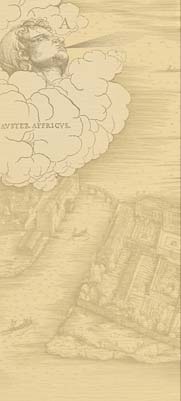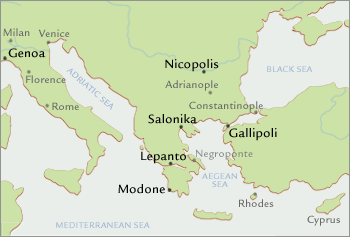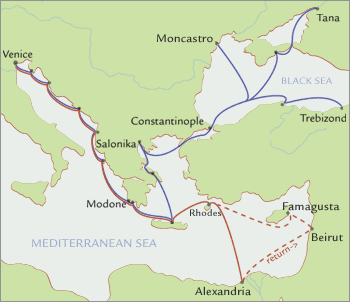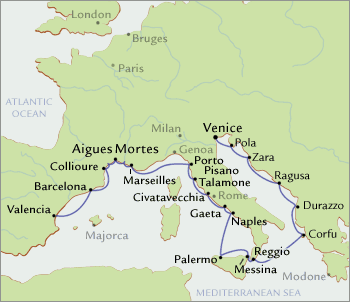Michael's Life: Comito 1421-1434
In 1421, Michael enlisted as a comito with the galleys of Romania, which was the name the Venetians gave to the Byzantine Empire. He served as comito in both the commercial and military galleys until 1434, also receiving three higher appointments. It was in 1434 that he began to write his manuscript.
Tasks of the comito
As comito, Michael was the officer in de facto command of a galley. Above him in official authority was a noble patron on a commercial galley or a sopracomito on a military galley. The comito was the highest non-noble officer on an individual galley and may have been the most experienced seaman on the ship. It was the comito who issued orders directly to the crew about when to row and when to sail.
The comito also managed course plotting and navigation, working in consultation with the patron, the paron, and especially the local pilots who were frequently on board. In addition, the comito saw to the preparation of the ship for battle and possibly even directed the crew during the actual fighting. In many ways, the comito was the ship's real captain. Certainly the crew looked to him for its orders.
Michael first served as comito in a commercial galley, but sailed in the Guard seven times during this phase of his career.
Michael's highest office: Armiraio
In 1422 Michael served in the Guard in the highest office he ever attained, that of armiraio to captain of the fleet Nicolo Capello. The armiraio was the highest office in the Venetian naval service (either merchant or military) to which a non-noble could aspire. It was the only office for a non-noble that involved direction of the whole fleet, rather than a single ship. The armiraio served on the flagship and was responsible for the movements of the fleets as well as the welfare and discipline of the crews. The position was a great honor for Michael. It was an honor that he was to obtain only three more times, in 1428, 1436, and 1440.
It was during his voyage as an armiraio that Michael suffered a great misfortune. He briefly notes in his service record that his son Teodorino died on this voyage. Teodorino must have been at least 16 at this time. Whether he died from wounds or disease, we don't know. Teodorino's mother, Dorotea, had died in 1415 while Michael was at sea.
Military voyages
Michael was soon involved in several major operations against the Turks around Salonika and at Gallipoli. In 1431, he fought in a major sea battle against the Genoese.
The trouble with the Turks began when Murad II came to the Ottoman throne in 1421, and Venice acquired control of Salonika in 1423. Salonika (also known as Thessalonica) was the second richest city in what was left of the Byzantine Empire. Murad wanted to add it to his own empire. He soon arrested the Venetian ambassador to his court and besieged the city.
In 1424, Michael sailed as comito in the fleet commanded by Pietro Loredan, which was sent to ravage the Turkish countryside around Gallipoli in an attempt to force Murad into peace negotiations.
In 1425, Michael served as comito in the fleet commanded by Fantin Michiel, and was soon involved in attacks on the ring of Turkish forts surrounding Salonika. In one such attack, Michael and his crew participated in an assault in which 40 Turks were killed and 30 captured. The Venetian fleet then sailed away to attempt an attack on Gallipoli. The fleet was driven off with the loss of 60 men.
Michael's commercial voyages to the Black Sea in 1426 and 1427 would bring him back to the increasingly desperate city of Salonika, where the galleys unloaded supplies for the defenders.
In 1428, Michael returned to the Guard, this time in the senior position of armiraio in the fleet commanded by Andrea Mocenigo. On this voyage he recorded Mocenigo's fleet orders, and later copied them into his manuscript (![]() 112a, 118a).
112a, 118a).
Michael's voyage with Mocenigo was unusual in that it lasted into 1429, when Mocenigo received orders to attack Gallipoli and try to recover the captured Venetian merchant ships kept in the harbor there. When the fleet arrived on June 30, 1429, they found that the Turks had built a huge wooden palisade across the harbor. Michael played a leading role in figuring out how to break through the palisade and carry out the attack.
All went well at first. Michael's ship entered the harbor accompanied by a few others. Then, as armiraio, Michael signaled the captains of the remaining galleys to join the attack as planned. They refused. Michael's ship and its escorts were then under fire from the Turks on all sides, the only way out being the narrow breach in the palisade they had made. They were forced to make a fighting retreat.
The mutinous captains were later tried. Some were convicted, but received mild punishments. Their cowardly behavior convinced the Turks they had little to fear from the Venetian navy. Salonika fell to Murad the next year.
The fall of Salonika was partly a result of the war that had broken out between Venice and Milan, ruled by Filipo Maria Visconti, who had also acquired control of Genoa. In 1431, Michael sailed against the Genoese as comito in a Guard fleet commanded by Pietro Loredan. The opposing forces met off the coast not far from Genoa on August 27. Two hours of fighting ended in a devastating defeat for the Genoese. Although Michael's exact role in the battle is unknown, the fighting was fierce, with hundreds killed or drowned. Michael himself was so badly injured that, as he wrote in his service record, he "went home over land wounded and broken."
He was not too broken, though, to sail in a second fleet commanded by Loredan the following year. The Venetians tried to prevent the Genoese from taking revenge for their earlier defeat, but the Genoese succeeded in burning the city of Corfu and sacking several Venetian possessions in the Aegean. Peace between the two cities was achieved the following year.
Commercial voyages
Michael made only one voyage to Flanders in this phase of his career, in 1430 as homo de conseio.
During this period, Michael sailed for the first time with merchant galleys to destinations in the East. Twice he sailed to Tana in the far northeast corner of the Black Sea (1421 and 1427); once he sailed to Trebizond in the southeast corner of the Black Sea (1426); and once to Alexandria, the main seaport of Egypt (1433). These places all stood at the end of trade routes that brought riches to the West from as far away as India and China. Among the goods that could be purchased in these ports were slaves, spices, and exceptionally beautiful silks and cottons.
The whole region was becoming increasingly dangerous as a result of strained relations with Turks, the Genoese, and even the sultan of Egypt. Because of the danger of pirates in the Eastern Mediterranean, the Alexandria convoy of 1423 sailed with that of Beirut, stopping at Michael's home island of Rhodes. This may have been his first visit there since he had left more than twenty years earlier.
Michael rounded out this period in 1434 with his only trip to Aigues Mortes, another of the official galley routes. On this voyage the Venetians traded Eastern goods for local produce, which they then resold as they traveled further along the coasts of France and Spain. Again, Michael may have been chosen for the voyage because of his battle experience. The route took him right past Genoa, with whom tensions had not entirely eased after the fighting of 1431.
< Paron | Homo de Conseio >














